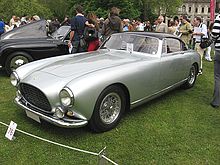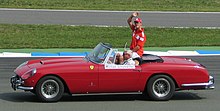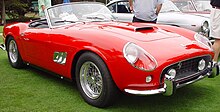Ferrari 250
The company's most successful early line, the 250 series includes many variants designed for road use or sports car racing.At 2,953 cc (180 cu in), it was notable for its light weight and impressive output of up to 300 PS (221 kW; 296 hp) in the Testa Rossa and GTO.The Mercedes-Benz W194 racers of Rudolf Caracciola, Hermann Lang, and Karl Kling were faster on the long straights but the 230 PS (169 kW; 227 hp) Ferrari made up sufficient ground in the hills and curves to win the race.The dry-sump 3.0 L (2,953 cc (180 cu in)) engine used three Weber 36DCF carburettors and was mated directly to a five-speed manual transmission.Pinin Farina then created coupé bodywork which had a small grille, compact tail and panoramic rear window, and the new car was launched as the 250 MM (for Mille Miglia) at the 1953 Geneva Motor Show.Carrozzeria Vignale's open barchetta version was also an innovative design whose recessed headlights and side vents became a Ferrari staple for the 1950s.0334MM was the sole chassis with Vignale Berlinetta body, distinctive for its triple portholes on the bottom of front fenders, not on top.When new, the GTO sold for $18,500 in the United States, and buyers had to be personally approved by Enzo Ferrari and his dealer for North America, Luigi Chinetti.In October 2013, the 1963 Ferrari 250 GTO chassis number 5111GT sold by Connecticut-based collector Paul Pappalardo to an unnamed buyer in a private transaction for US$52 million.Ferrari was unable to persuade the FIA that he would build the 100 examples required to homologate the car for GT racing.As a result, Ferrari withdrew from factory participation in the GT class of the 1965 World Sportscar Championship, allowing the Shelby Cobra team to dominate.It was a square engine, with 68 mm (2.7 in) of bore and stroke, developing 200 PS (147 kW; 197 hp) at 6,300 rpm, with three Weber 36DCF (or DCZ) carburettors, and mated to a 4-speed transmission.Echoing Vignale's 250 Europa, Pinin Farina added now-familiar vents to the front fenders, a standard styling cue for many of the 250 GTs that followed.0373 finished third at the Liège-Rome-Liège rally in 1956 Pinin Farina introduced a 250-based prototype coupé at the 1956 Geneva Motor Show which came to be called the 250 GT Boano.Intended as a styling exercise and inspiration to 250 GT Europa customers, the car generated demand that soon called for a production series.Unable to meet the demand without expansion, Pinin Farina asked Mario Boano, formerly of Ghia, to handle the construction.Released at the Geneva Motor Show in 1957, the original 250 GT Cabriolet Pinin Farina Series I used the 2,600 mm (102.4 in) wheelbase and the body was styled differently from the Berlinetta.Motor Trend Classic placed the 250 GT Series I Cabriolet and Coupé ninth on their list of the ten "Greatest Ferraris of all time".Needing series production to stabilize his company's finances, Enzo Ferrari asked Pinin Farina to design a simple and classic 250 GT coupé.The GT Coupé eschewed the fender vents for simple, clean lines and a notchback look with panoramic rear window.Interim vehicles have an additional rear quarter window, absent from the succeeding "Passo Corto" Berlinettas.Development of the 250 GT SWB Berlinetta was handled by Giotto Bizzarrini, Carlo Chiti, and young Mauro Forghieri, the same team that later produced the 250 GTO.Disc brakes were a first on a Ferrari GT, and the combination of low weight, high power, and well-sorted suspension made it competitive.In 1960, Scaglietti unveiled the 250 GT California Spyder SWB at the Geneva Motor Show, its body pulled more tautly over this updated chassis.Like the 250 GT Berlinetta SWB on which it was based, the revised Spyder also received disc brakes and a 280 PS (206 kW; 276 hp) version of the three-litre V12.[20][21][22] A barn-find 1961 SWB owned by French actor Alain Delon while he was making the 1964 film Les Felins with Jane Fonda sold for US$15.9 million in February 2015.Steve Boone, a member of the Rock and Roll Hall of Fame with the group Lovin' Spoonful owned chassis number #4237, which was stolen from a repair shop in Queens, New York and never found.His frustration with Enzo Ferrari's response to his complaints about frequent clutch problems was key to his decision to make his own cars.























FerrariDesignerGiotto BizzarriniScagliettiPinin FarinaVignaleGrand TourerBody styleBerlinettacabrioletcoupéLayoutLongitudinally-mountedfront-engine, rear-wheel-driveEngineColomboTransmissionmanualWheelbaseFerrari 212 InterFerrari 225 SFerrari 275Ferrari 330sports carsgrand tourerssports car racingColombo V12 engineGioacchino ColomboJaguar XK straight-6Ferrari 250 SMille MigliaGiovanni BraccoMercedes-BenzW194 racersRudolf CaracciolaHermann LangKarl KlingLe MansCarrera PanamericanaFerrari 250 MMParis Motor ShowCarrozzeria Vignalebarchetta625 TF and 735 SCarrozzeria MorelliClemente BiondettiFerrari 250 MonzaCarrozzeria ScagliettiFerrari 250 Testa RossaSebringBuenos AiresFerrari 250 GTOLuigi Chinettichassis numberauctionConnecticutcollectormillionMotor Trend Classic12 Hours of Sebring1000 km Nürburgring24 Hours of Le Mansrear mid-engine, rear wheel driveWorld Sportscar ChampionshipShelby CobraPrototype1965 24 Hours of Le MansFormula OneGiovanni Michelotti340 MexicoLiège-Rome-LiègeMario BoanoÉcurie FrancorchampsGoodwood Festival of SpeedTour de France automobile raceTour de France AutomobileMichael SchumacherFerrari 250 GT Cabriolet Pinin FarinaFerrari 250 GT California Spyder250 GT California SpyderTour de Franceracing cartorquenaturally aspiratedcylinderWeber carburetorsMonterey, CaliforniaPrince BertilTelescopic shock absorbersHoudaillesSuperfastCarlo ChitiMauro Forghieri250 GTODisc brakesSports Car InternationalTop Sports Cars of the 1960sFerris Bueller's Day OffNational Historic Vehicle RegisterJames CoburnChris Evansbarn-findAlain DelonLes FelinsJane FondaAmelia Island PlantationFerrari 250 GT LussofastbackEric ClaptonSteve McQueenSteve BooneLovin' SpoonfulMuseo Ferruccio LamborghiniFerruccio LamborghiniEnzo FerrariFerrari 250 GT DrogoPiero DrogoGiovanni VolpiSports Car MarketHistoric Vehicle AssociationFox NewsSports340 MM375 Plus375 MM166 S/166 MM